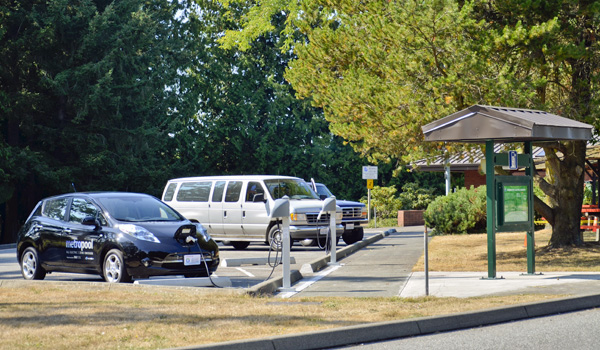Plug-in electric vehicle registrations have increased rapidly in Washington state. While most charging can be done at home for low cost, long-distance travel requires fast chargers that can deliver a charge while drivers take a short break. This study developed a simulation model to recommend where electric vehicle fast charging stations would be most useful to help WSDOT staff prioritize investments in fast charging infrastructure.
Plug-in electric vehicle (PEV) registrations in Washington state increased by 19 percent between November 2018 and July 2019. While the state is on track to achieve the Governor’s goal of 50,000 PEVs by 2020, the continued growth in PEV adoption will require continued growth in EV charging infrastructure. Although Washington hosts more than 400 public direct current fast charging (DCFC) plugs at 120 stations, it has roughly half as many fast charging stations per capita as neighboring Oregon.
Washington anticipates significant continued investment in DCFC infrastructure over the next several years. Given that funding is finite and DCFC stations are expensive, public investments must be made where they will have the biggest effect on EV adoption and travel.
To help WSDOT determine where it should invest in highway corridor DC fast charging, the researchers developed a simulation model in which users can specify the locations and characteristics of charging stations along Washington’s highway network (such as number of plugs and charging power). The model then calculates key performance indicators for the resulting charging network. The performance indicators include the following:
- Technical performance (such as vehicles served per day)
- Cost effectiveness (such as vehicles served per public dollar invested, operating costs and revenues at each charging station)
- Environmental sustainability (for example, EV registrations in Washington, electric vehicle miles traveled)
- Equity (such as percentage of state area served and public investment by county).
The developed modeling platform is modular, with different sub-models (EV ownership, long-distance trips, EV use, charging choices, charging station operations, and charging station costs) that can be refined over time. This will allow WSDOT to obtain useful results in the near term, while the model can also be improved as the market grows and the behavior of EV buyers and owners becomes better understood.
With the use of the decision support system, public agencies and private companies will be able to evaluate the feasibility of a set of charging station candidate sites and compare multiple siting scenarios.
The flexible nature of the model will allow users to test multiple policy objectives, for example, determine how EV supply equipment utilization would change if charging stations were placed at all locations so that all EV trips in Washington were feasible. Furthermore, the nature of the model allows for future integration of other models and systems that are related to EVs and EV infrastructure. This will allow the state to examine, for example, how the availability of EV infrastructure affects EV adoption and vice-versa, or how an increase in EV miles traveled affects the electric grid load.
Authors:
Don MacKenzie
Chintan Pathak
Parastoo Jabbari
UW Department of Civil and Environmental Engineering
Sponsor: WSDOT
WSDOT Technical Monitor: Tonia Buell
WSDOT Program Manager: Doug Brodin

